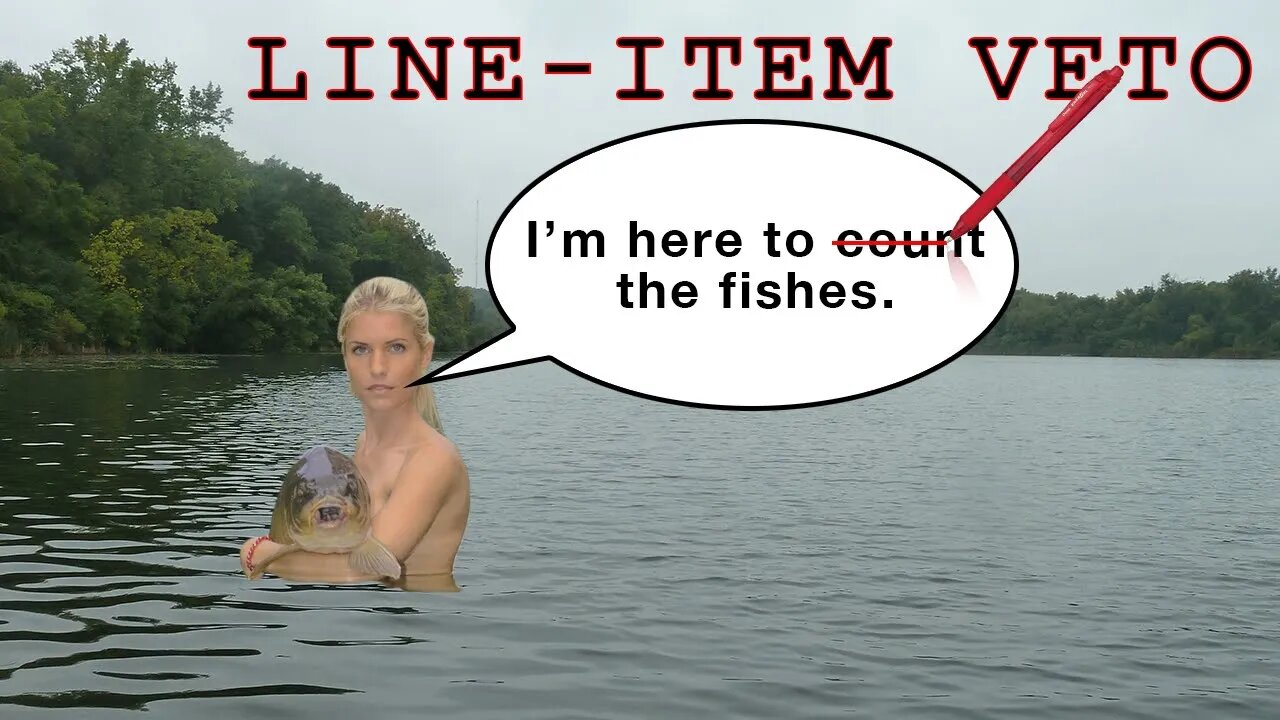Premium Only Content

Line-Item Veto EXPLAINED
There are a ton of earmarks passed each year, i.e. line-items tucked into bills to increase spending on a politician’s favorite pet project. Here are some famous examples…
The Big Dig: $22 billion to reroute a highway inside Boston.
The Bridge to Nowhere: $233 million to build a bridge to an Alaskan island with a permanent population of 50.
Turtle Tunnel: $3.4 million to construct a tunnel under a Highway north of Tallahassee so wildlife can safely cross.
1 Fish, 2 Fish: $2.5 million to count the number of amberjack fish in the Gulf of Mexico.
Drunk Mice: $15,000 to study how alcohol affects a mouse's motor function.
Now both the left and the right dislike pork because it’s arguably a form of corruption and because it enables politicians to be more incompetent by shifting attention away from their broken promises to Look! A turtle!
And the further right you are on the political spectrum then the more pork you see in our federal budget.
"The powers delegated by the proposed Constitution to the federal government are few and defined. Those which are to remain in the State governments are numerous and indefinite. The former will be exercised principally on external objects, as war, peace, negotiation, and foreign commerce."
"The Federal Government should be the last resort, not the first. Ask if a potential program is truly a federal responsibility or whether it can better be handled privately, by voluntary organizations, or by local or state governments."
As a conservative federalist, I believe the federal government should only fund those things that state governments cannot do more effectively themselves. After all, our poorest state has a bigger GDP than most countries so it only makes sense that our states fund their own dang projects...
... roads, museums, schools, relief, studios, businesses, firms, hospitals, organizations, charities, police, local governments, etc.
And it's so important to reduce the complexity of the federal government not just to reduce wasteful spending, but to also reduce wasteful focus. The American people can only focus on so many things before we become scattered brain. I rather our distant federal Capital be great at 100 things than incompetent at 100,000 things.
How can we cut the pork out of these bills?
A recurring bipartisan policy suggestion is the line-item veto.
The line-item veto is “is the power of an executive authority to nullify or cancel specific provisions of a bill, usually a budget appropriations bill, without vetoing the entire legislative package.”
At least 14 presidents from both parties have called for the authority to address individual spending items wrapped into larger bills. And 44 U.S. states currently give their governors some form of line-item veto power. If you consider that our U.S. constitution is modeled after state constitutions and vice versa then it isn’t hard to see why a U.S. President should have the same power too, especially because fiscal discipline has traditionally been harder at the federal level due to our federal government’s ability to just print money to avoid hard choices.
In fact, for a brief time, the president of the United States did have line-item veto power. In 1996, President Bill Clinton signed the Line Item Veto Act, which specifically granted the president the power to line-item veto budget bills.
But the act was quickly ruled unconstitutional in a 6-3 decision by the Supreme Court in Clinton v. City of New York based on the Presentment Clause and the fact that under the Line Item Veto Act the President would sign a bill and then unilaterally strike out a duly enacted law…
“The Line Item Veto Act is unconstitutional because it permits the President to unilaterally cancel provisions in a duly enacted statute.” —Justice Stevens, majority opinion
Justice Scalia — America’s most famous conservative originalist textualist Justice — dissented arguing that the line-item veto was constitutional because Presidents have long had the de facto power to make unilateral decisions on spending…
“There’s no difference between authorizing the President to cancel a spending item and allowing the President discretionary spending.” — Justice Scalia, dissenting opinion
Unfortunately, since the Supreme Court struck down the Line Item Veto Act, the number of earmarks has increased significantly.
-
 6:33
6:33
Anthony Galli
1 year agoHow Socialism Runs American “Capitalism”
42 -
 4:41:02
4:41:02
SynthTrax & DJ Cheezus Livestreams
1 day agoFriday Night Synthwave 80s 90s Electronica and more DJ MIX Livestream 80s Night / Late Night Nostalgia
43.4K5 -
 4:05:52
4:05:52
Nerdrotic
11 hours ago $16.76 earnedHollywood REGRET | Disney's Predator | The Feminist Avengers - Friday Night Tights 379
69.1K17 -
 2:36:22
2:36:22
Mally_Mouse
4 days agoFriend Friday!! 🎉 - Let's Play! - MIMESIS
34.7K3 -
 41:20
41:20
MattMorseTV
7 hours ago $28.19 earned🔴Schumer just BACKSTABBED his OWN VOTERS. 🔴
41K85 -
 3:33:34
3:33:34
MissesMaam
8 hours ago*Spicy* Friend Friday with Mally_Mouse!! 💚✨
15.4K3 -
 57:44
57:44
Candace Show Podcast
7 hours agoBen Shapiro Is Crying Again. | Candace Ep 261
67.7K246 -
 4:13:24
4:13:24
megimu32
7 hours agoOFF THE SUBJECT: MEMESIS w/ MALLY MOUSE | MISSES MAAM | SAVAGEJAYGATSBY
7.87K4 -
 5:58:48
5:58:48
a12cat34dog
7 hours agoI AM FINALLY BACK | Dying Light: The Beast x PUBG | COLLABORATION EVENT {18+}
5.86K3 -
 4:26:16
4:26:16
John_Goetz
7 hours agoJohn Gets Playing - Clair Obscur Expedition 33
3.28K2